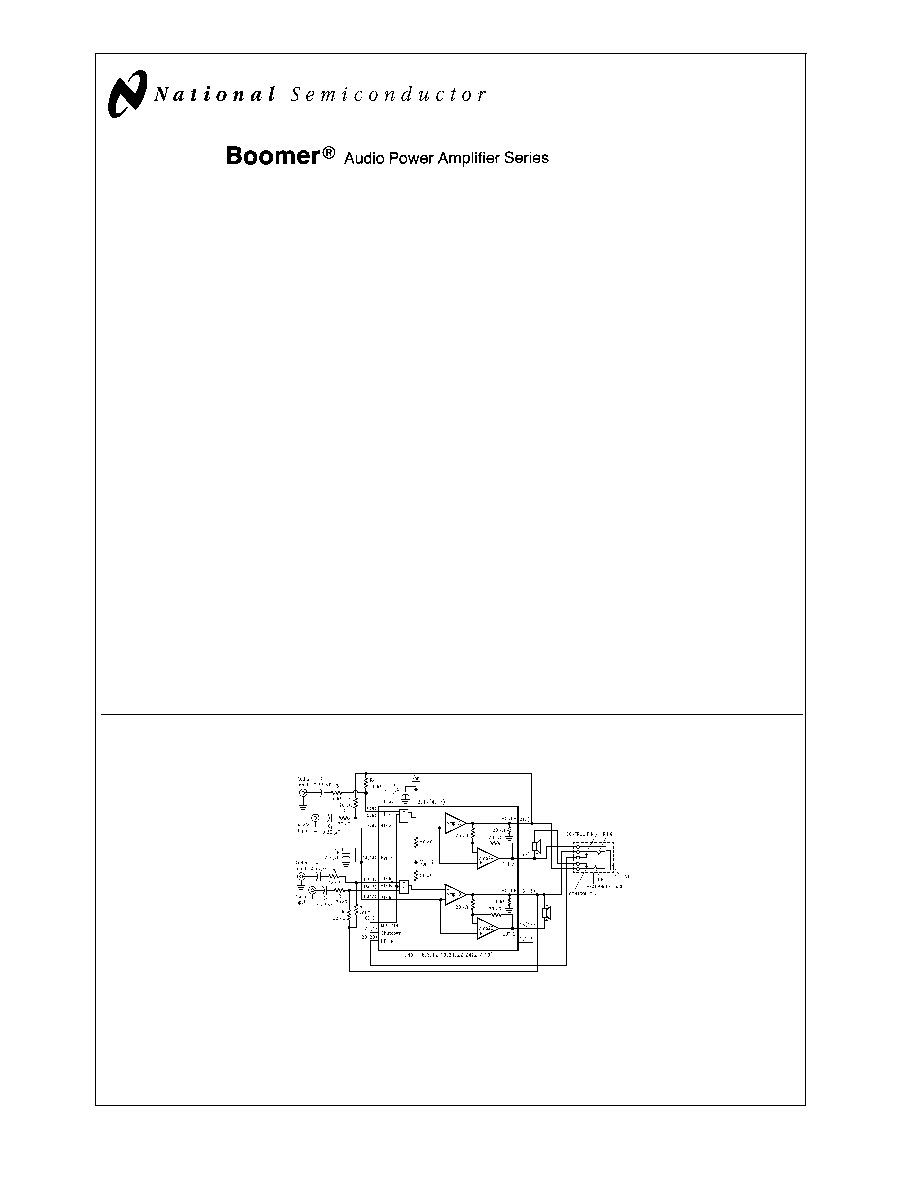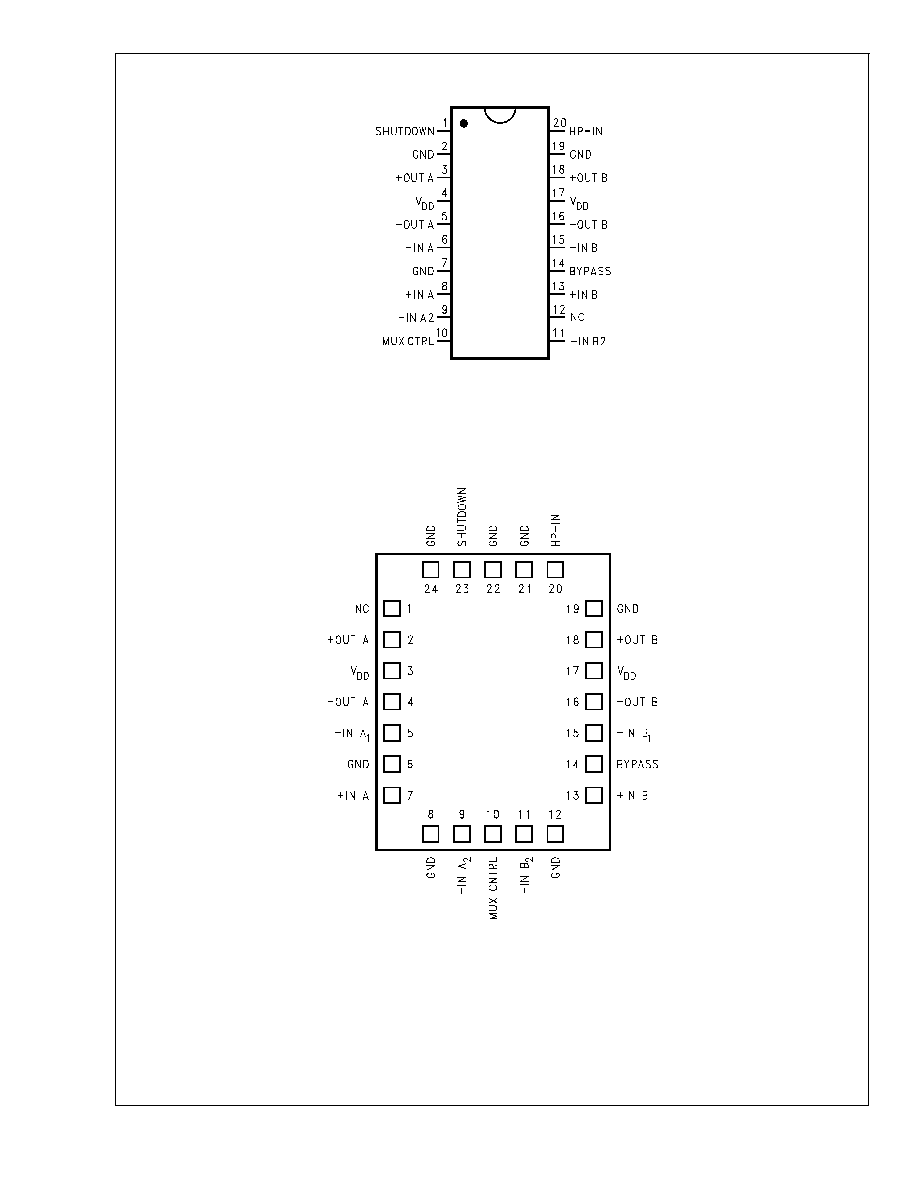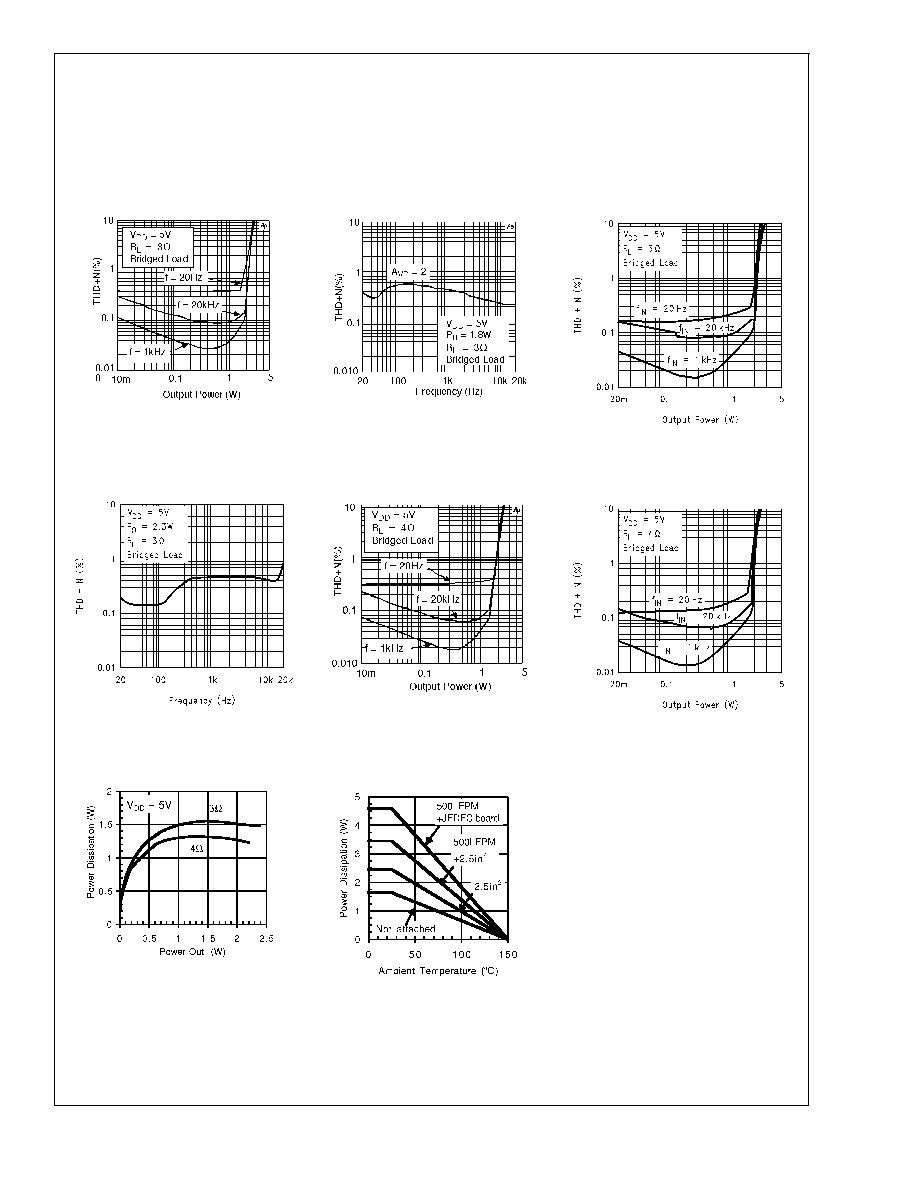
LM4867
Output-Transient-Free Dual 2.1W Audio Amplifier Plus
No Coupling Capacitor Stereo Headphone Function
General Description
The LM4867 is a dual bridge-connected audio power ampli-
fier which, when connected to a 5V supply, will deliver 2.1W
to a 4
load (Note 1) or 2.4W to a 3
load (Note 2) with less
than 1.0% THD+N. The LM4867 uses advanced, latest gen-
eration circuitry to eliminate all traces of clicks and pops
when the supply voltage is first applied. The amplifier has a
headphone-amplifier-select input pin. It is used to switch the
amplifiers from bridge to single-ended mode for driving
headphones. A new circuit topology eliminates headphone
output coupling capacitors. A MUX control pin allows selec-
tion between the two sets of stereo input signals. The MUX
control can also be used to select between two different
customer-specified closed-loop responses.
Boomer audio power amplifiers are designed specifically to
provide high quality output power from a surface mount
package and require few external components. To simplify
audio system design, the LM4867 combines dual bridge
speaker amplifiers and stereo headphone amplifiers in one
package.
The LM4867 features an externally controlled power-saving
micropower shutdown mode, a stereo headphone amplifier
mode, and thermal shutdown protection.
Note 1: An LM4867LQ or LM4867MTE that has been properly mounted to
a circuit board will deliver 2.1W into 4
. The Mux control can also be used to
select two different closed-loop responses. LM4867MT will deliver 1.1W into
8
. See the Application Information sections for further information concern-
ing the LM4867LQ and the LM4867MT.
Note 2: An LM4867LQ or LM4867MTE that has been properly mounted to a
circuit board and forced-air cooled will deliver 2.4W into 3
.
Key Specifications
n
P
O
at 1% THD+N
n
LM4867LQ, 3
load
2.4W (typ)
n
LM4867LQ, 4
load
2.1W (typ)
n
LM4867MTE, 4
1.9W (typ)
n
LM4867MT, 8
1.1W (typ)
n
Single-ended mode - THD+N at 75mW into 32
0.5%
(max)
n
Shutdown current
0.7�A (typ)
Features
n
Advanced "click and pop" suppression circuitry
n
Eliminates headphone amplifier output coupling
capacitors
n
Stereo headphone amplifier mode
n
Input mux control and two separate inputs per channel
n
Thermal shutdown protection circuitry
n
LLP, TSSOP, and exposed-DAP TSSOP packaging
available
Applications
n
Multimedia monitors
n
Portable and desktop computers
n
Portable audio systems
Typical Application
Boomer
�
is a registered trademark of National Semiconductor Corporation.
DS200013-31
*
Refer to the Application Information section titled PROPER SELECTION OF EXTERNAL COMPONENTS for details concerning the value of C
B
.
FIGURE 1. Typical Audio Amplifier Application Circuit
(Pin out shown for the 24-pin Exposed-DAP LLP package. Numbers in ( ) are for the 20-pin MTE and MT
packages.)
February 2001
LM4867
Output-T
ransient-Free
Dual
2.1W
Audio
Amplifier
Plus
No
Coupling
Capacitor
Stereo
Headphone
Function
� 2001 National Semiconductor Corporation
DS200013
www.national.com

Connection Diagram
Connection Diagram
DS200013-58
Top View
Order Number LM4867MT, LM4867MTE
See NS Package Number MTC20 for TSSOP
See NS Package Number MXA20A for Exposed-DAP TSSOP
DS200013-38
Top View
Order Number LM4867LQ
See NS Package Number LQA24A for Exposed-DAP LLP
LM4867
www.national.com
2

Absolute Maximum Ratings
(Note 3)
If Military/Aerospace specified devices are required,
please contact the National Semiconductor Sales Office/
Distributors for availability and specifications.
Supply Voltage
6.0V
Storage Temperature
-65�C to +150�C
Input Voltage
-0.3V to V
DD
+0.3V
Power Dissipation (Note 4)
Internally limited
ESD Susceptibility (Note 5)
All pins except Pin 3 (MT, MTE), Pin 2 (LQ)
2000V
Pin 3 (MT, MTE), Pin 2 (LQ)
8000V
ESD Susceptibility (Note 6)
200V
Junction Temperature
150�C
Solder Information
Small Outline Package
Vapor Phase (60 sec.)
215�C
Infrared (15 sec.)
220�C
See AN-450 "Surface Mounting and their Effects on
Product Reliablilty" for other methods of soldering surface
mount devices.
Thermal Resistance
JC
(typ) -- MTC20
20�C/W
JA
(typ) -- MTC20
80�C/W
JC
(typ) -- MXA20A
2�C/W
JA
(typ) -- MXA20A
41�C/W (Note 7)
JA
(typ) -- MXA20A
51�C/W (Note 8)
JA
(typ) -- MXA20A
90�C/W (Note 9)
JC
(typ) -- LQA24A
3.0�C/W
JA
(typ) -- LQA24A
TBD�C/W (Note 10)
JA
(typ) -- LQA24A
TBD�C/W (Note 11)
JA
(typ) -- LQA24A
TBD�C/W (Note 12)
Operating Ratings
Temperature Range
T
MIN
T
A
T
MAX
-40�C
T
A
85�C
Supply Voltage
2.0V
V
DD
5.5V
Electrical Characteristics for Entire IC
(Notes 3, 13)
The following specifications apply for V
DD
= 5V unless otherwise noted. Limits apply for T
A
= 25�C.
Symbol
Parameter
Conditions
LM4867
Units
(Limits)
Typical
Limit
(Note 14)
(Note 15)
V
DD
Supply Voltage
2
V (min)
5.5
V (max)
I
DD
Quiescent Power Supply Current
V
IN
= 0V, I
O
= 0A (Note 16) , HP-IN = 0V
7.5
15
mA (max)
V
IN
= 0V, I
O
= 0A (Note 16) , HP-IN = 4V
3.0
6
mA (max)
I
SD
Shutdown Current
V
DD
applied to the SHUTDOWN pin
0.7
2
�A (max)
Electrical Characteristics for Bridged-Mode Operation
(Notes 3, 13)
The following specifications apply for V
DD
= 5V unless otherwise specified. Limits apply for T
A
= 25�C.
Symbol
Parameter
Conditions
LM4867
Units
(Limits)
Typical
Limit
(Note 14)
(Note 15)
V
OS
Output Offset Voltage
V
IN
= 0V
5
50
mV (max)
P
O
Output Power (Note 17)
THD = 1%, f = 1kHz
LM4867MTE, R
L
= 3
(Note 18)
2.2
W
LM4867LQ, R
L
= 3
(Note 18)
2.2
W
LM4867MTE, R
L
= 4
(Note 19)
1.9
W
LM4867LQ, R
L
= 4
(Note 19)
1.9
W
LM4867, R
L
= 8
1.1
1.0
W (min)
THD+N = 10%, f = 1kHz
LM4867MTE, R
L
= 3
(Note 18)
3.0
W
LM4867LQ, R
L
= 3
(Note 18)
3.0
W
LM4867MTE, R
L
= 4
(Note 19)
2.6
W
LM4867LQ, R
L
= 4
(Note 19)
2.6
W
LM4867, R
L
= 8
1.5
W
THD+N = 1%, f = 1 kHz, R
L
= 32
0.34
W
LM4867
www.national.com
3

Electrical Characteristics for Bridged-Mode Operation
(Notes 3, 13) (Continued)
The following specifications apply for V
DD
= 5V unless otherwise specified. Limits apply for T
A
= 25�C.
Symbol
Parameter
Conditions
LM4867
Units
(Limits)
Typical
Limit
(Note 14)
(Note 15)
THD+N
Total Harmonic Distortion+Noise
20Hz
f
20kHz, A
VD
= 2
LM4867MTE, R
L
= 4
, P
O
= 2W
LM4867LQ, R
L
= 4
, P
O
= 2W
LM4867, R
L
= 8
, P
O
= 1W
0.3
0.3
0.3
%
%
%
PSRR
Power Supply Rejection Ratio
V
DD
= 5V, V
RIPPLE
= 200 mV
RMS
, R
L
= 8
,
C
B
= 2.2�F
67
dB
X
TALK
Channel Separation
f = 1 kHz, C
B
= 2.2�F
80
dB
SNR
Signal To Noise Ratio
V
DD
= 5V, P
O
= 1.1W, R
L
= 8
97
dB
Electrical Characteristics for Single-Ended Operation
(Notes 3, 13)
The following specifications apply for V
DD
= 5V unless otherwise specified. Limits apply for T
A
= 25�C.
Symbol
Parameter
Conditions
LM4867
Units
(Limits)
Typical
Limit
(Note 14)
(Note 15)
V
OS
Output Offset Voltage
V
IN
= 0V
5
50
mV (max)
P
O
Output Power
THD = 0.5%, f = 1kHz, R
L
= 32
85
75
mW (min)
THD+N = 1%, f = 1kHz, R
L
= 8
(Note
20)
180
mW
THD+N = 1%, f = 1kHz, R
L
= 16
THD+N = 10%, f = 1kHz, R
L
= 32
THD+N = 10%, f = 1kHz, R
L
= 16
THD+N = 10%, f = 1kHz, R
L
= 32
165
88
208
114
mW
mW
mW
mW
V
OUT
Output Voltage Swing
THD = 0.05%, R
L
= 5k
1
V
P-P
THD+N
Total Harmonic Distortion+Noise
A
V
= -1, P
O
= 75mW, 20 Hz
f
20kHz,
R
L
= 32
0.2
%
PSRR
Power Supply Rejection Ratio
C
B
= 2.2�F, V
RIPPLE
= 200mV
RMS
,
f = 1kHz
52
dB
X
TALK
Channel Separation
f = 1kHz, C
B
= 2.2�F
60
dB
SNR
Signal To Noise Ratio
V
DD
= 5V, P
O
= 340mW, R
L
= 8
94
dB
Note 3: Absolute Maximum Ratings indicate limits beyond which damage to the device may occur. Operating Ratings indicate conditions for which the device is
functional, but do not guarantee specific performance limits. Electrical Characteristics state DC and AC electrical specifications under particular test conditions which
guarantee specific performance limits. This assumes that the device operates within the Operating Ratings. Specifications are not guaranteed for parameters where
no limit is given. The typical value however, is a good indication of device performance.
Note 4: The maximum power dissipation must be derated at elevated temperatures and is dictated by T
JMAX
,
JA
, and the ambient temperature T
A
. The maximum
allowable power dissipation is P
DMAX
= (T
JMAX
- T
A
)/
JA
. For the LM4867, T
JMAX
= 150�C. For the
JA
s for different packages, please see the Application
Information section or the Absolute Maximum Ratings section.
Note 5: Human body model, 100 pF discharged through a 1.5 k
resistor.
Note 6: Machine model, 220 pF�240 pF discharged through all pins.
Note 7: The given
JA
is for an LM4867 packaged in an MXA20A with the Exposed-DAP soldered to an exposed 2in
2
area of 1oz printed circuit board copper.
Note 8: The given
JA
is for an LM4867 packaged in an MXA20A with the Exposed-DAP soldered to an exposed 1in
2
area of 1oz printed circuit board copper.
Note 9: The given
JA
is for an LM4867 packaged in an MXA20A with the Exposed-DAP not soldered to printed circuit board copper.
Note 10: The given
JA
is for an LM4867 packaged in an LQA24A with the Exposed-DAP soldered to an exposed 2in
2
area of 1oz printed circuit board copper.
Note 11: The given
JA
is for an LM4867 packaged in an LQA24A with the Exposed-DAP soldered to an exposed 1in
2
area of 1oz printed circuit board copper.
Note 12: The given
JA
is for an LM4867 packaged in an LQA24A with the Exposed-DAP not soldered to printed circuit board copper.
Note 13: All voltages are measured with respect to the ground (GND) pins, unless otherwise specified.
Note 14: Typicals are measured at 25�C and represent the parametric norm.
Note 15: Limits are guaranteed to National's AOQL (Average Outgoing Quality Level). Datasheet min/max specification limits are guaranteed by design, test, or
statistical analysis.
Note 16: The quiescent power supply current depends on the offset voltage when a practical load is connected to the amplifier.
Note 17: Output power is measured at the device terminals.
Note 18: When driving 3
loads from a 5V supply, the LM4867LQ, LM4867MTE, or LM4867MTE-1 must be mounted to the circuit board and forced-air cooled (450
linear-feet per minute).
Note 19: When driving 4
loads from a 5V supply, the LM4867LQ, LM4867MTE or LM4867MTE-1 must be mounted to the circuit board.
LM4867
www.national.com
4

Electrical Characteristics for Single-Ended Operation
(Notes 3, 13) (Continued)
Note 20: See Application Information section 'Single-Ended Output Power Performance and Measurement Considerations' for more information.
Typical Performance Characteristics
MTE- and LQ- Specific Characteristics
Note 21: This curve shows the LM4867MTE's thermal dissipation ability at different ambient temperatures given these conditions:
500LFPM + JEDEC board: The part is soldered to a 1S2P 20-lead exposed-DAP TSSOP test board with 500 linear feet per minute of forced-air flow across
it.
Board information - copper dimensions: 74x74mm, copper coverage: 100% (buried layer) and 12% (top/bottom layers), 16 vias under the exposed-DAP.
500LFPM + 2.5in
2
: The part is soldered to a 2.5in
2
, 1 oz. copper plane with 500 linear feet per minute of forced-air flow across it.
2.5in
2
: The part is soldered to a 2.5in
2
, 1oz. copper plane.
Not Attached: The part is not soldered down and is not forced-air cooled.
LM4867MTE
THD+N vs Output Power
DS200013-33
LM4867MTE
THD+N vs Frequency
DS200013-34
LM4867LQ
THD+N vs Output Power
DS200013-53
LM4867LQ
THD+N vs Frequency
DS200013-54
LM4867MTE
THD+N vs Output Power
DS200013-36
LM4867LQ
THD+N vs Output Power
DS200013-55
LM4867LQ, LM4867MTE
Power Dissipation vs Power Output
DS200013-61
LM4867LQ, LM4867MTE(Note 21)
Power Derating Curve
DS200013-59
LM4867
www.national.com
5




